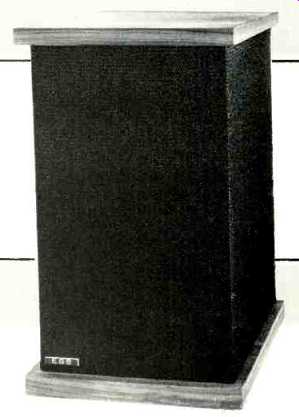
MANUFACTURER'S SPECIFICATIONS
System Type: Resistance loaded port.
Speaker Components: 9-in. by 12-in. bass; 5-in. cone mid-range, and 2 1/4-in. dome tweeter.
Frequency Response: 40-20,000 Hz +/- 3½-dB.
Crossover Points: 550 and 2,700 Hz.
Dimensions: 16 in. by 14 in. by 27 in.
Weight: 65 lbs.
Price: $299.00.
ESS stands for Electrostatic Sound Systems, but the name is a little misleading as not all of their systems use electrostatic units-in fact, most of them are dynamic! The ESS Mk VII, which we tested, is a small floor-standing system using a wrap-around grille cloth which gives it a distinctive appearance. The bass unit is an elliptical type made by KEF in England, and it employs a flat polystyrene diaphragm measuring about 13 in. by 9 in. Mid-range speaker is a 5-in. cone type and the HF speaker has a 2 in. cone with a small center dome. Crossover points are 550 and about 3,000 Hz. The system is not a conventional reflex but has a resistance loaded port which puts it nearer the totally enclosed system category in some respects. System resonance is 50 Hz. At the rear is a three-position level control for the treble unit. The rather solid-looking top and bottom cabinet sections are made of walnut but rosewood is also available. The grille cloth is brown which will harmonize with most furnishing schemes.

Listening Tests
The first impression of the VII's was a solid, full bass response-even when the units were placed on a table, three feet from the floor. The best positions were actually on the floor near the corners of the room--about two feet away--or placed flat against the wall. Angling slightly inward gave the best stereo image-especially if the systems were placed more than 12 ft. apart. Overall sound had a forward quality compared with our lab standard systems but coloration was commendably low. Later measurements confirmed the excellent dispersion and high power handling capabilities. (A Phase Linear 400 was used for some of the tests--this unit can really put out some watts!) Preamp was a Sony 2000F and the phono cartridge, a Decca Mk-5-a nice combination.
Measurements
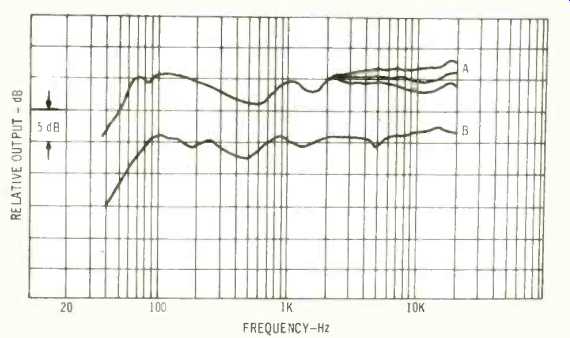
Fig. 1--Frequency response with one-third octave pink noise. A was taken on-axis
at the three positions of the treble switch and B at 45 degrees off-axis.
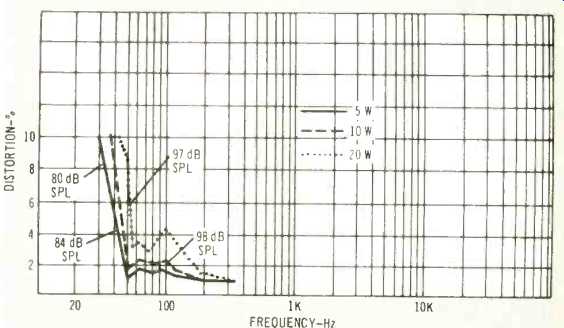
Fig. 2--Low frequency distortion and SPL.
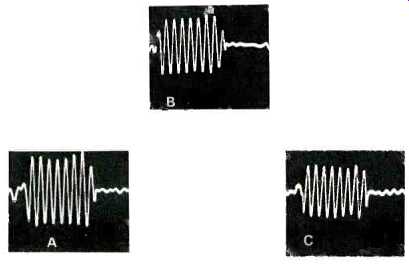
Fig. 3--Tone burst characteristics at A, 100 Hz; B, 1,000 Hz, and C, 5,000
Hz.
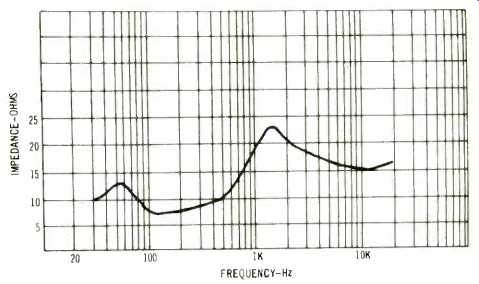
Fig. 4--Impedance versus frequency.
Figure 1 shows the frequency response taken with one-third octave pink noise. Curve A is the response on-axis at the three positions of the treble control, and B is the response 45 degrees off-axis. As can be seen the response is exceptionally smooth from 2,000 Hz up with good dispersion. Figure 2 shows the low frequency distortion and some representative SPL measurements for 5, 10, and 20 watt inputs. Frequency doubling commenced at 50 watts input at 40 Hz and with 84 watts input at 70 Hz. The system could handle a continuous sine wave power of 105 watts at 100 Hz without audible signs of distress. Response to tone bursts was excellent as can be seen from Fig. 3. Lowest point in the impedance characteristics is 5.8 ohms with a high of 23. The rise at resonance is quite low (12.3 ohms), indicating a low-Q system. White noise tests showed no serious coloration-just a trace of low frequency noise. All-in-all, the ESS VII can be recommended to those who require a floor-standing system of reasonable size-and not too expensive. Sensitivity was just a little below average and we would agree with the maker's suggested figure of a minimum amplifier power of 25 watts per channel for an average room.
-T.A. & G.W.T.
(adapted from Audio magazine, Jan. 1973)
Also see:
ESS amt-1 Speaker System (Dec. 1973)
EPI 601 Speaker Systems (Jan. 1973)
Dynaco A-25XL Loudspeaker (Equip. Profile, Nov. 1976)
= = = =